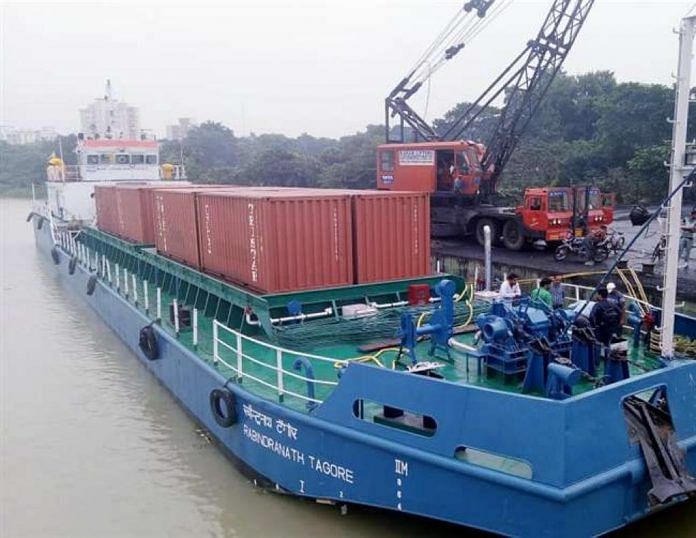In a historic first, India has launched the transport of container cargo aboard inland vessels, a greener way to ferry goods.
New Delhi: India pulled off an important post-Independence first this week as a container took off from Kolkata to Varanasi aboard an inland vessel.
Container cargo transport reduces the handling cost, pilferage as well as damage, and also leaves a lower carbon footprint.
The PepsiCo container is expected to reach its destination on 12 November, to be greeted on arrival by Prime Minister Narendra Modi, among others.
This should have been the biggest news of the week in India. For the first time since independence, a container is moving on inland vessel. PepsiCo is moving 16 containers from Kolkata to Varanasi on vessel MV RN Tagore, over river Ganga. Such a huge accomplishment!#SagarMala
— Nitin Gadkari (@nitin_gadkari) November 3, 2018
PepsiCo (India) will move 16 containers – equivalent to 16 truckloads – filled with food and snacks aboard the vessel MV RN Tagore, with each trip taking nine to 10 days.
Also read: A short history of the seaplane that Narendra Modi used in Gujarat
MV RN Tagore will make its return journey with fertilisers from IFFCO.
The launch of operations Tuesday followed 15 successful pilot runs on national waterways (Ganga and Brahmaputra).
“Since 2016, there have been 15 big runs on the national waterways on different stretches like Kolkata to Farakka, Patna-Bhagalpur, Banaras-Bhagalpur etc and things like stones, coals, fertilisers, fly ash have been carried on them,” Inland Waterways Authority of India (IWAI) chairman Pravir Pandey said.
“When we started with Maruti cars, it was only a pilot project,” he added, “Initially, only 3-4 million tonnes of cargo was moving on the waterways but now we have crossed 5-5.5 million tonnes… The significant part [of Tuesday’s event] is that a container on a ship on a river [was] flagged off for the first time in India.”
More feasible
According to Pandey, the transport of cargo through inland waterways would offer a third alternative to those who find the conventional road and rail routes inconvenient.
Inland water transport is also more cost feasible: Where it takes Rs 40,000 per tonne to transport containers by road, transport via rivers costs Rs 35,000 per tonne. According to Pandey, the cost for river transport eventually worked out Rs 2 per tonne per km.
Pepsi paid the IWAI Rs 12 lakh for the transportation of their containers.
The first pilot run in 2016 saw the transport of 25 Maruti from Kolkata to Varanasi in seven days, but no consignment of cars was sent after that.
Also read: Boats to the rescue: Waterways to help decongest Mumbai’s packed roads & locals
Asked why, Pandey said it was not viable to send only 25 cars via ship, adding that a ship built to transport more vehicles was in the works.
“This is why we have already got a new ship designed from Germany and we shall build it now,” he added. “This ship has been designed to carry approximately 350 cars…which will be commercially viable. This ship will ready with us by next October.”
The government is developing National Waterway-1 (River Ganga) under the Jal Marg Vikas Project (JMVP) from Haldia to Varanasi (1,390 Km), with technical and financial assistance from the World Bank, at an estimated cost of Rs 5,369 crore. The project would enable commercial navigation of vessels with a capacity of 1,500-2,000 DWT (Deadweight tonnage, the amount of weight a ship can carry).




Many schemes which BJP government is launching may be shelved by new government if BJP loses power. And then maybe relaunched after a few years. For waterways to succeed, we need sufficient water around the year. In a drought year, this mode of transportation will fail. Also, the river should not be polluted by ships and should not kill aquatic animals.